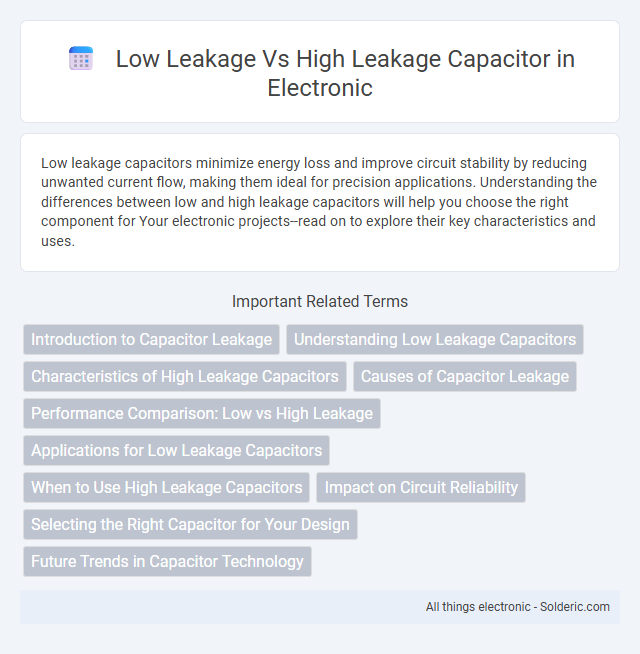Low leakage capacitors minimize energy loss and improve circuit stability by reducing unwanted current flow, making them ideal for precision applications. Understanding the differences between low and high leakage capacitors will help you choose the right component for Your electronic projects--read on to explore their key characteristics and uses.
Comparison Table
| Feature | Low Leakage Capacitor | High Leakage Capacitor |
|---|---|---|
| Leakage Current | Minimal leakage current (nanoamperes to microamperes) | Higher leakage current (microamperes to milliamperes) |
| Dielectric Material | High-quality dielectrics (e.g., polypropylene, polystyrene) | Lower-quality dielectrics (e.g., electrolytic) |
| Applications | Precision circuits, timing applications, filter circuits | Power supply smoothing, general-purpose, decoupling |
| Cost | Higher cost due to superior materials and manufacturing | Lower cost, commonly used in bulk applications |
| Stability | High stability with low leakage over time | Lower stability, leakage increases with age and temperature |
| Size | Usually larger for given capacitance | Smaller size for given capacitance |
Introduction to Capacitor Leakage
Capacitor leakage refers to the small amount of current that bypasses the dielectric, causing energy loss over time. Low leakage capacitors feature high-quality dielectrics with minimal current flow, making them ideal for precision applications such as medical devices and data acquisition systems. High leakage capacitors, often used in less critical circuits, exhibit greater current loss, which can impact circuit stability and efficiency in long-term usage.
Understanding Low Leakage Capacitors
Low leakage capacitors minimize unwanted current flow, preserving charge and ensuring circuit stability in sensitive electronic applications. These capacitors are ideal for precision analog circuits and memory retention, offering longer lifespan and improved reliability over high leakage types. Understanding the role of low leakage capacitors can enhance your device's performance by reducing power loss and maintaining signal integrity.
Characteristics of High Leakage Capacitors
High leakage capacitors exhibit increased current flow through the dielectric, resulting in higher power dissipation and reduced efficiency in circuits. These capacitors often have lower insulation resistance and are prone to faster degradation, affecting reliability in sensitive electronic applications. Their characteristics make them suitable for non-critical filtering and timing tasks where leakage current impacts are minimal.
Causes of Capacitor Leakage
Capacitor leakage occurs due to imperfections in the dielectric material, allowing small currents to pass through even when the capacitor is charged. High leakage capacitors often have poor quality dielectrics or aging effects that increase conduction paths, while low leakage capacitors utilize superior materials and manufacturing processes to minimize these currents. Moisture penetration, contamination, and physical damage also contribute to increased leakage by degrading the dielectric integrity.
Performance Comparison: Low vs High Leakage
Low leakage capacitors provide superior performance in circuits requiring minimal current loss, ensuring greater energy efficiency and stability over time, especially in precision analog applications. High leakage capacitors, while typically more cost-effective, suffer from increased current drain that can degrade circuit accuracy and reduce battery life in portable devices. Your choice between low and high leakage capacitors directly impacts the reliability and efficiency of sensitive electronic designs.
Applications for Low Leakage Capacitors
Low leakage capacitors are essential in precision analog circuits, medical equipment, and battery-operated devices where minimal current loss is critical to maintaining signal integrity and energy efficiency. These capacitors are widely used in sample-and-hold circuits, audio applications, and medical instrumentation to ensure accurate performance and long-term reliability. Selecting the appropriate low leakage capacitor can significantly improve your device's stability and extend battery life.
When to Use High Leakage Capacitors
High leakage capacitors are suitable in applications where rapid discharge or controlled leakage current is necessary, such as timing circuits, snubbers, or where voltage must not remain stored for long periods. These capacitors provide a lower cost and can tolerate higher leakage currents without performance issues, making them ideal for non-critical filtering or coupling in audio circuits. You should choose high leakage capacitors when leakage current does not significantly affect circuit operation or efficiency.
Impact on Circuit Reliability
Low leakage capacitors enhance circuit reliability by minimizing current loss, reducing power consumption, and preventing potential damage to sensitive components. High leakage capacitors can cause voltage drops and increased heat generation, leading to premature failure or erratic circuit behavior. Choosing the right capacitor ensures your design maintains stable performance and long-term durability.
Selecting the Right Capacitor for Your Design
Low leakage capacitors are ideal for precision circuits requiring minimal current loss, preserving signal integrity and extending battery life in your design. High leakage capacitors may be suitable for applications where slight current loss is acceptable, offering cost-effective solutions with higher capacitance values. Understanding the leakage current specifications and operational environment ensures you select the capacitor that balances performance and reliability.
Future Trends in Capacitor Technology
Low leakage capacitors are increasingly favored in energy-efficient and high-precision applications due to their minimal power loss and enhanced reliability. Emerging materials like advanced ceramics and polymer electrolytes are driving improvements in leakage performance, enabling longer device lifespans and reduced maintenance. Your choice between low and high leakage capacitors will depend on balancing cost, performance, and the specific demands of future electronic innovations.
Low leakage vs high leakage capacitor Infographic

 solderic.com
solderic.com